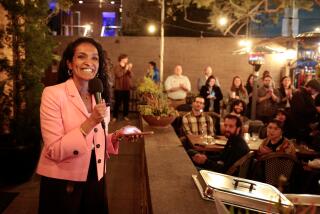Anaheim’s feeble democracy
The Anaheim City Council showed its contempt for the principle of representative government again this week, defeating another proposal to let residents vote for council members on a district-by-district basis. The decision means that the voting power of the city’s growing Latino population will remain diluted for now. But it’s easy to envision a day when demographic change overtakes the city’s political elite, and the shoe will be on the other foot.
The council has previously stiff-armed efforts to change the city charter and end at-large voting, a practice that enables more politically active residents of the wealthier parts of the city — along with entrenched special interests — to dictate the council’s membership. The ethnically diverse city, now more than half Latino, has elected only a handful of non-white council members in its history. The five current members are all white. And over the years, few have come from the densely populated, lower-income parts of the city.
With more than 330,000 residents, Anaheim is the largest city in California that still has at-large voting. Proponents of the shift to district voting argue that it would lead to a more equitable distribution of resources for parks, libraries and other city services. Those resources are now concentrated, they complain, in the better-off neighborhoods. Opponents counter that the change would only lead to intra-council feuding. But if there’s harmony at the council table today, it’s only because the city’s majority has no seats there.
Mayor Tom Tait has been trying for months to persuade the council to let the public vote on the issue. Last year his proposed ballot measure was blocked in favor of creating a citizens’ commission to study the issue. The commission agreed with Tait that the city should put the issue of district voting on the ballot and urged that the council be expanded by two to four members. But at a raucous meeting Tuesday night, the council rejected the proposal, 3 to 2.
Instead, the council decided to put an alternative on the June 2014 primary ballot that would make the council seem more representative without actually shifting political power. The proposal by Councilwoman Kris Murray would divide the city into districts, and the representative from each district would have to reside there. But the elections would still be decided by at-large voting, just as they are today. As Jose Moreno, a grass-roots activist and proponent of district elections, neatly summarized the situation on the Voice of OC website, “You may get some Latino candidates elected, but it won’t be Latinos that elect them.”
Is it so hard to understand why that’s wrong?
The council may soon find itself without a voice in the process; the American Civil Liberties Union is suing to force the city to abandon at-large voting on the grounds that it violates the California Voting Rights Act by impairing Latinos’ ability to influence elections. And even if the city prevails, it’s swimming against the demographic tide. When Latinos hold the majority not just in the census but also among active voters, the interests that rule today may rue the day they refused to share power.
More to Read
A cure for the common opinion
Get thought-provoking perspectives with our weekly newsletter.
You may occasionally receive promotional content from the Los Angeles Times.






